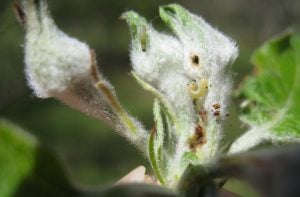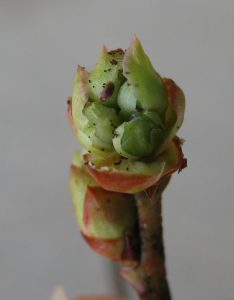Apple IPM April 14, 2020
April 14, 2020
Hi Fruit Growers,
Hope everyone made it through yesterday’s storm alright. I know many people are still without power.
Yesterday’s warm rain created an apple scab infection period. If your apple trees were not protected with a fungicide before yesterday’s rain you should apply a fungicide with kickback activity soon. Scala and Vangard are good fungicides to use this time of year if your trees were not well protected with a fungicide and you spray after an scab infection period has occurred. Other fungicides with kickback include Rally, Rubigan, Flint, and several others.
We are at the time of year when all infection periods are important and your trees should always be protected with a fungicide. We may get lucky this week. It looks like it will rain tonight and some showers tomorrow, but it will be fairly chilly. Look at the apple scab infection period on the New England Pest Management Guide website for hours of leaf wetness needed to cause an apple scab infection period: https://netreefruit.org/apples/diseases/apple-scab/apple-scab-infection-periods
At 45 degrees, it takes 14 hours of leaf wetness to cause a slight infection period, 23 hours for a moderate infection, and 37 hours for a heavy infection. We don’t start counting hours until the sun is up since very few spores are released at night. We can also use NEWA from Cornell to help measure infection periods. Liz Garofalo from UMass gave a good overview of NEWA on the Zoom twilight meeting last Thursday. The videos from last week’s meeting will be posted soon. You can also contact me and we can go over how to use NEWA.
I’ve been monitoring winter moth eggs hatching in three locations in RI. Most eggs have hatched by now. Next week will be a good time to check apple and blueberry buds for winter moth caterpillars. Collect at least 20 flower buds, pull buds apart and look with a magnifying glass for small caterpillars or insect frass. It’s much easier to find frass than caterpillars. See pictures below.
We don’t have a really good threshold to indicate whether or not to spray for winter moth caterpillars. Some Nova Scotia guides recommend spraying when 1-2 caterpillars are found in 20 buds. A good time to spray for winter moths is at bud separation – when the flower buds start separating from the cluster. Of course not all varieties are at the same bud development, so, if needed, spray when the earlier varieties are in bud separation. It seems like all commonly used and labeled insecticides control winter moth caterpillars well. Bt insecticides (such as Dipel) are also effective.
I’m available to make farm visits and please feel free to call, email or text me. 401-256-7438. And please join us for the next Zoom meeting. Not sure when that will be, but I’ll let you know.
Apple buds pulled apart and finding winter moth caterpillars and frass.
Blueberry bud pulled apart showing winter moth frass. A caterpillar is in lower part of bud.
 Home
Home Browse
Browse Close
Close Events
Events Maps
Maps Email
Email Brightspace
Brightspace eCampus
eCampus




